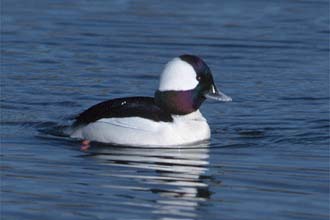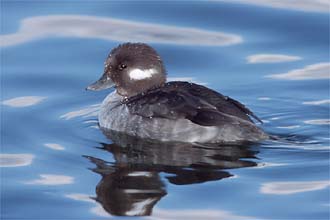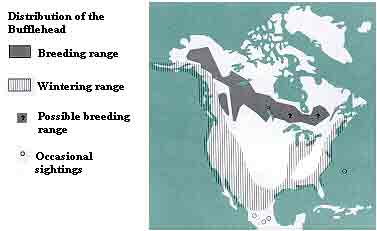Bufflehead (Bucephala Albeola)
 The
Bufflehead is the smallest diving duck. Strikingly
patterned in black and white, and constantly active. These
compactly built birds become much heavier during migration
gaining several onces of stored fat as fuel for travel. This
is where they derive the name "butterballs." Like their near
relatives, the goldeneyes and mergansers, Bufflehead males
do not attain adult plumage until their second winter, and
first breed when nearly two years old. it usually stays with
its own species in small groups.
The
Bufflehead is the smallest diving duck. Strikingly
patterned in black and white, and constantly active. These
compactly built birds become much heavier during migration
gaining several onces of stored fat as fuel for travel. This
is where they derive the name "butterballs." Like their near
relatives, the goldeneyes and mergansers, Bufflehead males
do not attain adult plumage until their second winter, and
first breed when nearly two years old. it usually stays with
its own species in small groups.
Adult Males are black above and white below, with bright pink feet. They wear a white "shawl" around the back of the head, and a broad white band extends from front to back across each wing. Adult females and first-year males are more drab, with the dark areas sooty-grey or brownish rather than black, and the white areas duller and smaller in size than in adult males.
 Both
sexes are normally silent, and the only sound commonly heard
from Buffleheads is the "grrk" call of females alarmed near
nest or brood.
Both
sexes are normally silent, and the only sound commonly heard
from Buffleheads is the "grrk" call of females alarmed near
nest or brood.
Breeding Courtship occurs through the winter, becoming more intensive as spring approaches, but most pairing seems to take place during the spring migration, and the birds are paired by the time they reach breeding areas. Males outnumber females, as in most diving ducks, so an appreciable proportion of adult males remains unpaired. In most areas Buffleheads start nesting soon after their arrival. The female Bufflehead lays her eggs in a tree cavity, usually the former nest of a Flicker (woodpecker). The related goldeneyes and mergansers are also tree-nesters.
 Habitat:Breeding:
Lakes, ponds, small streams in the forest zone south of the
tundra. They seldom nest by rivers and larger lakes as do
the other related species, possibly because these waters are
inhabited by northern pike, a large fish which readily feeds
on small ducklings. Wintering: Shallow, sheltered waters of
coves, river mouths, and lagoons, which have a muddy or
gravelly bottom. They often feed around old pilings of
wharves or log booms. Range: Breeding: From Central Alaska
through Canada to north central Quebec and south to the
United States border. Wintering: Along the Western coast
from Alaska to Baja California. Through Mexico and lower
Texas and across the Gulf Coast region . Along the east
coast from Nova Scotia into Florida. They are also observed
inland along the eastern coast.
Habitat:Breeding:
Lakes, ponds, small streams in the forest zone south of the
tundra. They seldom nest by rivers and larger lakes as do
the other related species, possibly because these waters are
inhabited by northern pike, a large fish which readily feeds
on small ducklings. Wintering: Shallow, sheltered waters of
coves, river mouths, and lagoons, which have a muddy or
gravelly bottom. They often feed around old pilings of
wharves or log booms. Range: Breeding: From Central Alaska
through Canada to north central Quebec and south to the
United States border. Wintering: Along the Western coast
from Alaska to Baja California. Through Mexico and lower
Texas and across the Gulf Coast region . Along the east
coast from Nova Scotia into Florida. They are also observed
inland along the eastern coast.
Food:Their main foods are arthropods, mostly insect larvae in fresh water and small crustaceans (shrimps, crabs, amphipods) in salt water. In fall many seeds of aquatic plants are eaten, and in winter small marine snails or freshwater clams are taken in their respective habitats.